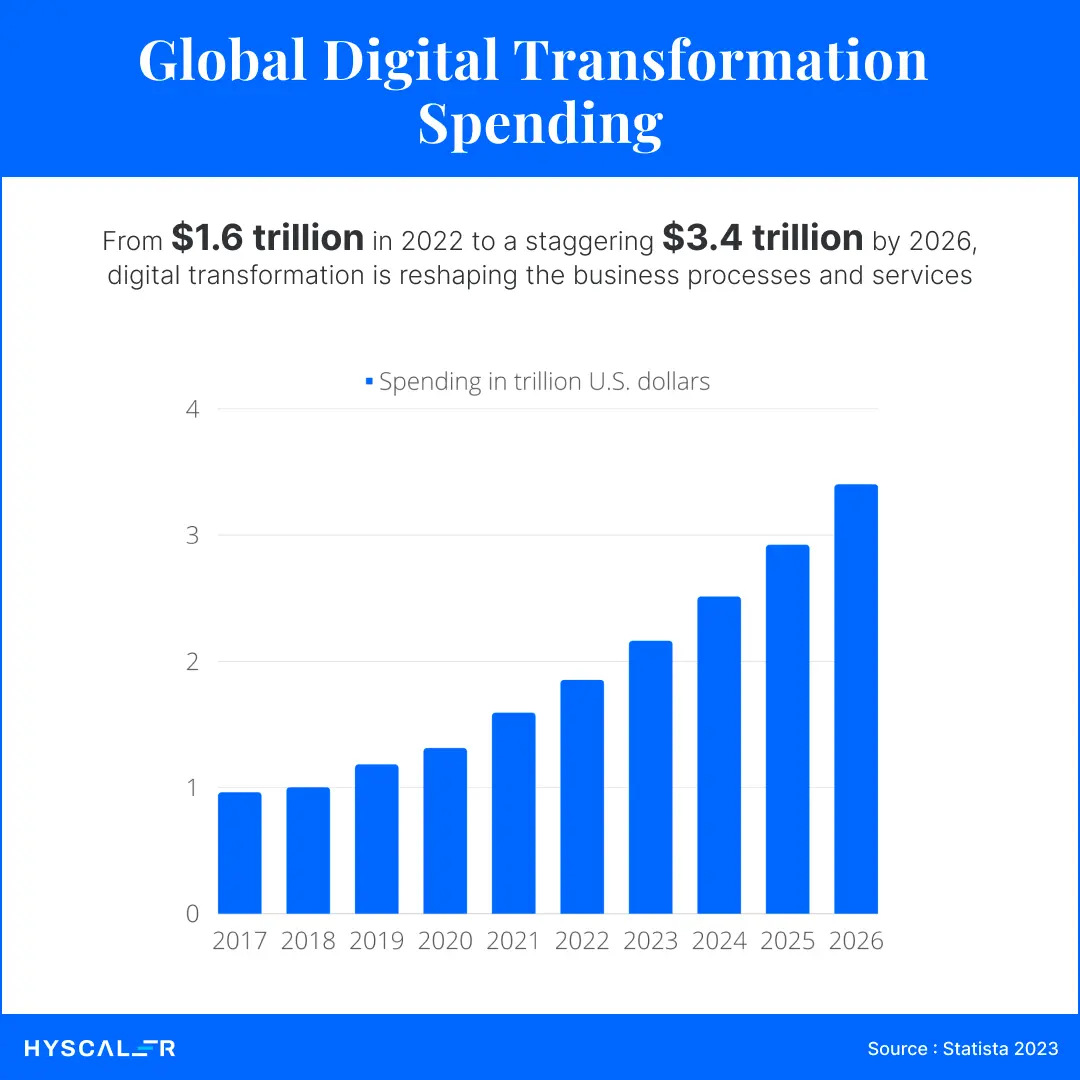Table of Contents
Digital transformation has become a necessity for businesses in today’s fast-paced and technology-driven world. It is not just about implementing new technologies but also about reshaping processes, culture, and mindset to drive growth and remain competitive.
In this article, we will explore the key components of crafting a winning digital transformation strategy.
Understanding Digital Transformation
Digital transformation entails the infusion of digital technologies across an organization, fundamentally reshaping its operations and the value it provides to its clientele. It involves leveraging technology to create new business models, improve customer experiences, increase operational efficiency, and drive innovation.
Organizations that embrace digital transformation can gain a competitive edge by staying responsive to evolving market trends and customer demands. However, the process is complex and requires a well-thought-out strategy to ensure success.
Let’s dive deeper into the world of digital transformation and explore its importance, key elements, and the benefits it can bring to organizations.
The Importance of Digital Transformation
Digital transformation is now more critical than ever. Rapid advancements in technology and changing consumer expectations have disrupted traditional business models. Companies that fail to adapt risk becoming irrelevant or losing market share to more digitally savvy competitors.
By embracing digital transformation, organizations can unlock a world of opportunities. It allows them to streamline operations, enhance agility, optimize decision-making processes, and leverage data-driven insights to drive growth and innovation.
For example, a retail company that adopts digital transformation can implement e-commerce platforms, personalized marketing strategies, and advanced analytics to better understand customer preferences and deliver tailored experiences. This can result in increased customer satisfaction, higher sales, and improved brand loyalty.
Furthermore, digital transformation enables organizations to tap into emerging technologies such as artificial intelligence, machine learning, and the Internet of Things (IoT). These technologies can revolutionize business processes, automate repetitive tasks, and enable predictive analysis, leading to improved efficiency and cost savings.
Key Elements :
While every organization’s digital transformation journey is unique, some common elements can contribute to their success:
- Clear Vision and Leadership: A well-defined digital transformation vision and strong leadership are crucial to rally support, drive change, and ensure alignment across the organization. Leaders need to communicate the benefits of digital transformation and inspire employees to embrace the necessary changes.
- Customer-Centric Approach: Understanding customer needs and preferences is essential for designing digital experiences that deliver value and build lasting relationships. Organizations should invest in customer research, data analytics, and user experience design to create seamless and personalized interactions across various digital touchpoints.
- Agile and Collaborative Culture: Building a culture that embraces change, encourages experimentation, and fosters collaboration is vital for driving innovation and adapting to evolving market dynamics. Organizations should empower employees to take risks, learn from failures, and continuously improve processes and products.
- Empowered Workforce: Equipping employees with the necessary digital skills and tools is essential for them to thrive in a digital-first environment and contribute to the organization’s success. Training programs, upskilling initiatives, and a supportive learning culture can help employees adapt to new technologies and ways of working.
- Robust Technology Infrastructure: Implementing the right technology infrastructure is a foundation for successful digital transformation. It should enable scalability, flexibility, and security to support future growth. Organizations should invest in cloud computing, cybersecurity measures, data management systems, and integration platforms to create a robust digital ecosystem.
By focusing on these key elements, organizations can navigate the complexities of digital transformation and position themselves for long-term success in the digital age. Digital transformation is a strategic imperative for organizations seeking to thrive in today’s fast-paced and technology-driven business landscape.
It offers numerous benefits, including improved customer experiences, increased operational efficiency, and the ability to drive innovation. By embracing digital transformation and incorporating the key elements discussed, organizations can stay ahead of the curve and seize new opportunities in the digital era. According to the forecast, by 2026, global digital transformation spending will reach 3.4 trillion U.S. dollars.

Building a Framework
Successful execution demands meticulous planning, strategic deliberation, and a profound grasp of the company’s aims and aspirations. Below are essential steps to contemplate in this endeavor.
1. Identifying Business Goals
The first step in crafting a winning digital transformation strategy is to align it with your organization’s overarching business goals. This involves understanding the current state of the organization, its strengths, weaknesses, opportunities, and threats. By conducting a thorough analysis, you can identify the desired outcomes and prioritize initiatives that will have the most significant impact on achieving those goals.
Break down these goals into smaller, actionable objectives that can guide the transformation journey and allow for incremental progress. This approach ensures that the transformation process remains manageable and measurable, enabling you to track progress and make necessary adjustments along the way.
2. Aligning Technology with Business Objectives
Technology plays a crucial role in digital transformation, but it should always be aligned with the organization’s business objectives, as seen in many successful examples of digital transformation Before investing in any technology solution, it is essential to evaluate existing systems and identify areas where technology can enable process optimization, improve customer experiences, or drive innovation.
Invest in technologies that can scale with your business and provide a foundation for future growth. Consider factors such as interoperability, data security, and vendor reliability when selecting technology solutions. It is also important to involve key stakeholders from different departments to ensure that the chosen technologies meet their specific needs and requirements.
Furthermore, it is crucial to establish a robust governance structure to oversee the implementation and management of technology solutions. This includes defining roles and responsibilities, establishing clear communication channels, and regularly monitoring and evaluating the performance of the technology systems to ensure they continue to align with the organization’s business objectives.
3. Developing a Change Management Strategy
Implementing a digital transformation framework often requires significant changes in processes, workflows, and employee roles. Therefore, it is essential to develop a comprehensive change management strategy to ensure a smooth transition and minimize resistance to change.
Start by creating awareness and building a sense of urgency among employees about the need for digital transformation. Communicate the benefits and opportunities that the transformation will bring, and address any concerns or fears they may have. Provide training and support to help employees develop the necessary skills and competencies required for the new digital environment.
Additionally, it is crucial to foster a culture of innovation and continuous learning within the organization. Encourage employees to embrace new technologies and ideas, reward innovation, and create channels for collaboration and knowledge sharing.
By developing a change management strategy that focuses on people, processes, and technology, organizations can overcome resistance to change and ensure a successful digital transformation. Building a digital transformation framework is a complex and multifaceted process. It requires a deep understanding of the organization’s goals, alignment of technology with business objectives, and a comprehensive change management strategy.
By following these key steps and continuously evaluating and adjusting the framework, organizations can navigate the digital transformation journey effectively and position themselves for long-term success.
Overcoming Challenges

While digital transformation offers great rewards, it also presents unique challenges that organizations must overcome to succeed.
1. Legacy Systems and Resistance to Change
Many organizations are hindered by legacy systems that are not designed for the digital age. These systems can be deeply ingrained, making it difficult to adapt to new digital technologies. Additionally, resistance to change from employees and leadership can impede progress.
2. Cybersecurity Concerns
The expansion of digital landscapes opens up new avenues for cyberattacks. Ensuring the security of digital assets, customer data, and intellectual property is a critical challenge that organizations must address.
3. Data Privacy and Compliance:
Stricter data privacy regulations, such as GDPR and CCPA, require organizations to handle customer data with care. Complying with these regulations while utilizing customer data for business insights presents a significant challenge.
4. Talent Shortage:
The demand for digital skills often exceeds the available talent pool. Attracting and retaining individuals skilled in data analytics, artificial intelligence, cybersecurity, and other digital competencies can be challenging.
5. Integration Complexities:
Integration of new digital technologies with the existing systems can be complex. Ensuring seamless communication between different platforms, software, and devices is crucial for a successful digital transformation.
These challenges underscore the importance of careful planning, investment, and change management in the process of digital transformation. Join hands with HyScaler to ease your Digital Transformation process.
Measuring the Success
Tracking and measuring the success of digital transformation initiatives is essential to evaluate their impact and refine strategies for continuous improvement.
Key Performance Indicators
Identifying key performance indicators (KPIs) that align with your business goals is crucial to measure the success of digital transformation efforts. These KPIs can vary depending on the nature of your organization, but some common ones include revenue growth, customer satisfaction, operational efficiency, and employee productivity.
Regularly monitor and analyze these KPIs to gain insights into the effectiveness of your digital transformation strategy and make data-driven decisions.
Continuous Improvement and Adaptation
Digital transformation is a continuous journey rather than a singular event. It requires organizations to embrace a culture of continuous improvement and adaptation to stay ahead of evolving market trends and customer expectations.
Regularly evaluate the effectiveness of your digital initiatives, gather feedback from stakeholders, and iterate your strategy accordingly. Embrace innovation and remain agile to capitalize on emerging technologies and opportunities.
Future Trends in Digital Transformation
As technology continues to evolve, so will the opportunities and challenges in digital transformation. Here are a couple of future trends that organizations need to keep an eye on:
The Role of AI and Machine Learning
Artificial intelligence (AI) and machine learning (ML) are poised to play a significant role in future digital transformations. These technologies can automate processes, enhance decision-making, and unlock new insights from vast amounts of data.
Organizations leveraging AI and ML will have a competitive advantage in areas such as personalized customer experiences, predictive analytics, and supply chain optimization.
The Impact of 5G and IoT on Digital Transformation
The widespread adoption of 5G connectivity and the Internet of Things (IoT) will further accelerate digital transformation. 5G’s higher speed and lower latency will enable more connected devices and seamless interactions, paving the way for innovative applications in various industries.
IoT devices will generate vast amounts of data, providing organizations with valuable insights for optimizing processes, improving products, and delivering personalized experiences at scale.
Conclusion
In today’s digital era, crafting a winning digital transformation strategy is essential for organizations to stay competitive and thrive. It requires a clear vision, a customer-centric approach, a robust technology infrastructure, and a culture of continuous improvement and adaptation.
By overcoming challenges, aligning technology with business objectives, and measuring success through meaningful KPIs, organizations can navigate the complexities of the digital transformation journey and unlock new opportunities for growth and innovation.
As technology continues to evolve, organizations must stay informed about emerging trends like AI, ML, 5G, and IoT, to capitalize on their potential and stay ahead of the competition. Join hands with HyScaler to begin your digital transformation journey today.





